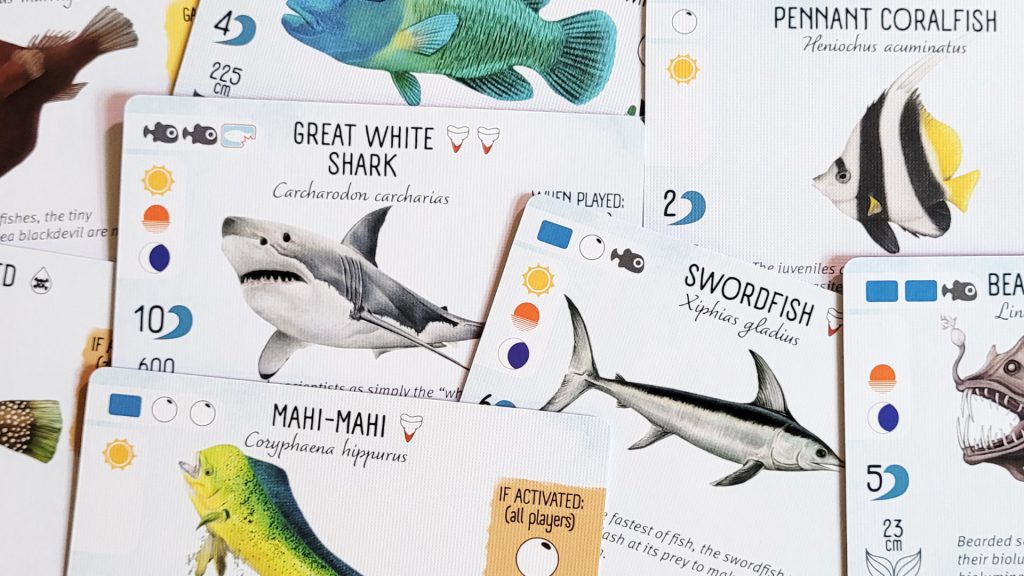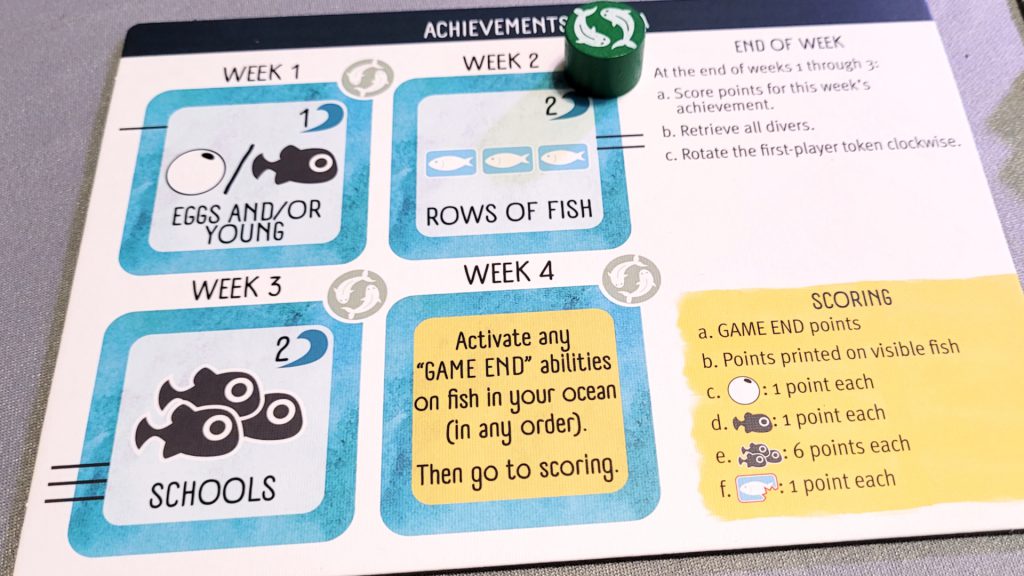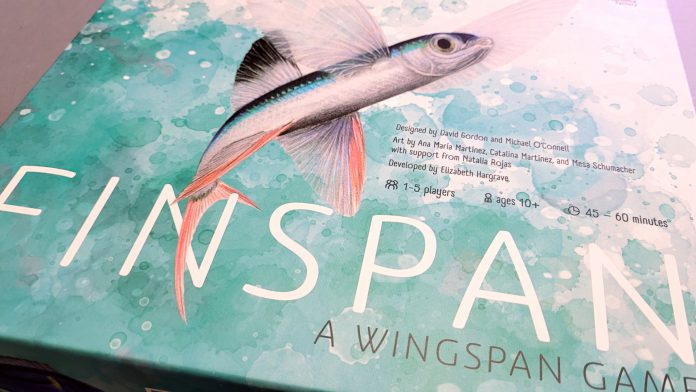Now Available in Fish Flavor
Wingspan was a phenomenon when it hit game stores in 2019. It quickly secured a place alongside Ticket to Ride and Pandemic as a gateway game that appealed to a growing market of casual board gamers who aren’t necessarily fans of science fiction or fantasy. Instead, its appeal lies in its beautiful artwork and relatively non-confrontational game play. Plus, you will find that there are plenty of people who geek out about birds the same way others do about wizards or superheroes.
After five years, more than seven printings, and two expansions, Wingspan is still going strong, and its phenomenal popularity has led to that inevitable sign of success: the re-skin. Wyrmspan arrived in 2024 to grab the fantasy fans whose imaginations may not have been engaged by the thought of a game about mere birds. And now we have Finspan, which moves the action under water to provide a surprisingly entertaining game about fish.
A Fish by Any Other Name
It’s been several years since I played Wingspan, and I just played Wyrmspan for the first time a few weeks ago, so I only have a basic familiarity with either game. But, as Theodore Roosevelt may or may not have said, “comparison is the thief of joy” – I will try to evaluate Finspan on its own terms.

Finspan consists of a board divided into columns, a deck of cards featuring a dizzying array of different fish species, and tokens representing eggs and young, the game’s primary currency. The boards are pre-printed with three “forage fish,” and also marked with the positions of starting eggs and young, making setup a breeze. In addition, players start with a hand of five cards, two of which are starter fish designed to be played early in the game.
The game is played over four rounds, using a combination of worker placement and card play. Players begin with six divers (workers), giving them six turns each round. A turn can either be spent playing a card, or diving for resources.
Cards represent different types of fish, and are played in rows and columns on the board. Most have a limit to which rows they can be played in – the rows indicate water depth. Some fish are also restricted by which of the three columns they can be played in. Fish cards have a cost to play, generally a combination of resources such as eggs, young, and/or cards from your hand. Larger predator fish also require that they “eat” smaller fish in play, taking their place on the board.

Positioning your fish strategically is important due to the way a dive turn works. Instead of playing a card, you choose one of the three columns on your board and move down, row by row, activating abilities on your fish cards. This is how you gain resources such as eggs and card draws, and how you hatch your eggs into young. In addition to being used to pay for cards, young can also be moved around the board and replaced by schools when there are three in one location. Schools are another resource, but also worth victory points at the end of the game.
The main strategy is in placing your cards in such a way as to make the most of your dive turns. In addition to grouping young into schools, victory points are scored from the fish themselves, as well as from smaller fish that the larger predators consume. There is also an achievement board, which awards bonus points at the end of each round based on randomly chosen criteria such as the number of young or eggs, or the number of fish of different sizes or with different tags like bioluminescent or predator.

Fish or Fowl?
So how does Finspan compare to its stable-mates? The publisher calls out Wyrmspan as the heaviest of the three, with Wingspan in the middle and Finspan on the lighter end, and I have to agree with that. Finspan definitely isn’t “my little Wingspan,” but it is simpler and smoother, which makes it easier to learn and teach as well as making the play time shorter — Finspan plays in 45-60 minutes as opposed to Wingspan’s 60-70 minutes and Wyrmspan’s 90 minutes or more.
The player boards start with several pre-printed fish, which gets the game going more quickly, and in general there are fewer restrictions on which rows and columns cards can be played to, which makes turns quicker and more productive.
The only real player interaction is positive – some fish have “all players” bonuses when activated. This makes for a pleasant game experience, but since it doesn’t really matter to you what your opponents are doing, waiting for your turn can be a little tedious, especially at longer player counts. Finspan is probably best at 2-3 players and works pretty well as a solo game.
Plenty of the Fish in the Sea
Finspan doesn’t really do anything all that original, but what it does, it does well. The game play is smooth and straightforward, with meaningful choices but not a lot of analysis paralysis.
It’s very much a point-salad race, with no direct interaction between players, but that’s not necessarily a bad thing. There is something very appealing about games that aren’t zero-sum; I don’t have to make you lose in order to win, I just have to score more points with my fish than you do with yours. We can stay out of each other’s way, build our separate tableaux, and see who comes out ahead at the end of the game.
The artwork on the boards and cards is lovely, with the only weak spot being the the egg and young tokens, which look a little cartoony and out of place compared to the rest of the game’s refined aesthetic. But that’s a minor complaint, and if you really want to you can get a component upgrade pack with meeples for the young, and “squishy” (the publisher’s words, not mine) egg tokens. I can’t wait to see what those are like…
If you’re looking for something light and relaxing, want to dip your toe into the Wingspan family of games, or just really like fish, you could do a lot worse than Finspan. Or you could hold out for Cthulhuspan, but something tells me that might be a long way off…
Have any questions or feedback? Drop us a note in the comments below or email us at contact@goonhammer.com. Want articles like this linked in your inbox every Monday morning? Sign up for our newsletter. And don’t forget that you can support us on Patreon for backer rewards like early video content, Administratum access, an ad-free experience on our website and more.


